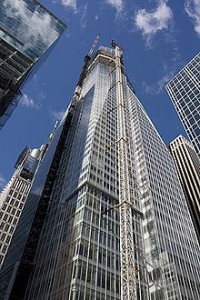 Although it’s been dubbed the greenest skyscraper by its supporters, some suggest the Bank of America building in Manhattan is a perfect illustration of the LEED rating system’s shortcomings. Despite being loaded with eco-friendly technology and achieving the LEED Platinum rating (the highest possible), the building is still relatively inefficient.
Although it’s been dubbed the greenest skyscraper by its supporters, some suggest the Bank of America building in Manhattan is a perfect illustration of the LEED rating system’s shortcomings. Despite being loaded with eco-friendly technology and achieving the LEED Platinum rating (the highest possible), the building is still relatively inefficient.
Cutting-Edge Technology
From a quick glance at the advanced technology built into the Bank of America tower, it would seem the title “greenest skyscraper” is well deserved. Nearly every aspect of the building has been designed to reduce its environmental impact:
- The building was constructed with locally sourced and recycled materials.
- Insulated glazing lets in abundant daylight while retaining heat to reduce reliance on electric heating.
- Lights dim automatically when daylight is sufficient.
- Rainwater is harvested for reuse in the building’s greywater system.
- Waterless urinals reduce water consumption.
- Stale air is filtered before being exhausted from the building.
- The building’s cogeneration power plant supplies enough electricity for 80 percent of the building’s minimum needs.
Even with all these innovations, however, the building still consumes more energy per square foot than other Manhattan buildings of similar sizes, according to New York City data. The Empire State Building, for example, uses half the energy, despite being 80 years older and running with retrofitted technology.
So how did a building with such a high LEED rating end up being so inefficient? Critics suggest the building’s developers took advantage of a serious flaw in the LEED ratings system. Namely, that designers can collect points for measures that have relatively little impact on the building’s total eco-friendliness. Rack up enough “easy” points and you’ve got a high rating.
Still others note that while the LEED ratings system isn’t perfect, it does provide a strong incentive for architects to actually use the energy-saving innovations available today. In addition, as the LEED, Green Globes and other ratings systems develop, they’ll become more accurate at rating what really matter.
To stay up to date on eco-friendly building trends like those found in the greenest skyscraper, get in touch with us at Construction Monitor.
Image via Shutterstock.com
